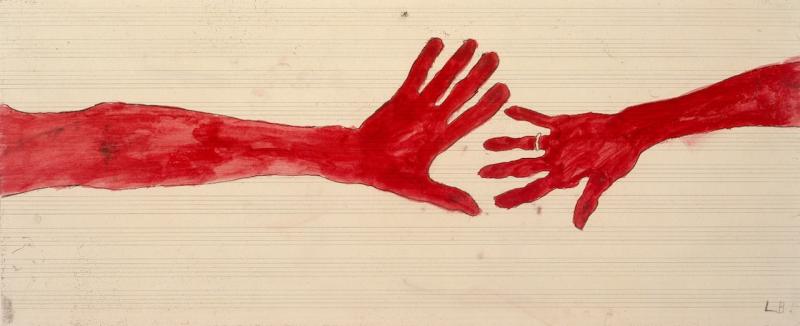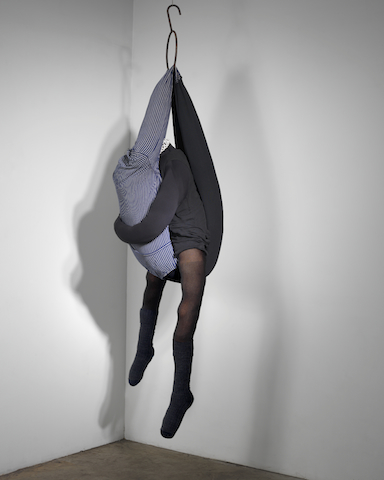Louise Bourgeois, Scottish National Gallery of Modern Art | reviews, news & interviews
Louise Bourgeois, Scottish National Gallery of Modern Art
Louise Bourgeois, Scottish National Gallery of Modern Art
A thoughtful survey of the artist's late works which highlight a single-minded drive for precision of expression

There’s a giant spider in the Scottish National Gallery of Modern Art’s new exhibition of Louise Bourgeois. Her trademark spider and the fact that she lived to 98 – working into her final days – are probably two of the best-known things about her.
She seems not only to be looking back on roads taken but still selecting and refining memories
The gallery lends itself to a spare and arresting presentation of objects conceived and created by what one senses must have been an exacting and demanding personality. She seems never to have given up seeking greater and greater understanding, and possibly acceptance, of wounding personal experiences which consumed her all her life.
Do you need to know her biography to understand what her art is about or to appreciate it? No – but it helps. The fact that her parents ran a tapestry repair workshop where Bourgeois herself worked suggests the importance the woven thread and the spider would assume in her later iconography. Her father’s betrayal of her mother, and her own worry and uncertainty as to whether she was living up to her role as good wife and mother were central concerns that she tried to come to terms with through years of therapy and in her art.
She has been called the founder of confessional art, and herself admitted:
“My reminiscences help me to live in the present, and
I want them to survive.
I am a prisoner of my emotions
You have to tell your story, and
You have to forget your story” ……….
“my pieces of sculpture
do not represent only studies in form, they
represent emotional states
usually of a painful kind”
 The particular arrangement of the exhibition ensures enough space to see each object clearly and to have time to consider their underlying concepts. Bourgeois often uses either large glass cases or wire cages to enclose her sculpture. Rooms within rooms seem to suggest the mind enclosed within the body and within the world, where things can be framed, sorted and presented as you want them to be: secrets revealed, though obliquely. (Pictured right: Couple I, 1996.)
The particular arrangement of the exhibition ensures enough space to see each object clearly and to have time to consider their underlying concepts. Bourgeois often uses either large glass cases or wire cages to enclose her sculpture. Rooms within rooms seem to suggest the mind enclosed within the body and within the world, where things can be framed, sorted and presented as you want them to be: secrets revealed, though obliquely. (Pictured right: Couple I, 1996.)
Looking at her use of textiles, embroidered messages and clothing in works such as Ode a la Bievre, 2007, and the Untitled (I have been to Hell and Back), 1996, you can’t help thinking of Tracey Emin with whom Bourgeois collaborated in one of her last works Do not Abandon me and ask who was influencing and encouraging whom? Both are artists exploring aspects of female identity, expressing and exposing intimate thoughts.
On a wall at the very heart of the exhibition hang 16 large sketchy etchings arranged in rows four by four. These make up one of her last major works, A L’Infini, 2008-9. They intrigue like vast Rorschach blots. In the light of the biographical details the exhibition has provided up to that point, the viewer begins to interpret and see things in the images – are they woollen threads and needles being pulled through the template of a tapestry, blood surging through veins or emptying from them, a map of twisting roads, river and streets, random knots, sperm, sections of electric wires, tree branches in the wind? Red is the predominant colour. Whatever they were intended to be, their meanderings carry a charge of energy and vital movement. Did Louise Bourgeois want them like the rest of her art to be a Rorschach test? A way of encouraging self-reflection and starting a conversation about a person's internal world?
Is it old age and sheer persistence which allows her to reach this point where everything is pared down to the essential, to find precise symbols and other highly personalised means of expressing her deepest fears and disappointments? In the film accompanying the exhibition, made just a few years before her death, she says she has only just realised life can be seen as a journey. She seems not only to be looking back on roads taken but still selecting and refining memories, still trying to make sense of the past and its impact.
There is a single-minded drive for precision of expression behind all her work whether in sculpture, drawings, etchings, paintings, embroidery or textiles. There is little warmth but there is an immense energy, an urge towards getting life under some form of control with everything carefully placed and framed and explained. Even the palette of colour used in most of the works is limited like a self-imposed uniform of red, black and white.
I came out of the exhibition feeling I had confronted a fiercely independent intelligence restlessly striving to bring a sense of order to a difficult world. Helped by the immaculately designed installation and the elegance of the beautifully proportioned rooms, such order is at least temporarily achieved.
- Louise Bourgeois: A Woman Without Secrets at the Scottish National Gallery of Modern Art, Edinburgh, until 18 May 2014
Explore topics
Share this article
The future of Arts Journalism
You can stop theartsdesk.com closing!
We urgently need financing to survive. Our fundraising drive has thus far raised £49,000 but we need to reach £100,000 or we will be forced to close. Please contribute here: https://gofund.me/c3f6033d
And if you can forward this information to anyone who might assist, we’d be grateful.

Subscribe to theartsdesk.com
Thank you for continuing to read our work on theartsdesk.com. For unlimited access to every article in its entirety, including our archive of more than 15,000 pieces, we're asking for £5 per month or £40 per year. We feel it's a very good deal, and hope you do too.
To take a subscription now simply click here.
And if you're looking for that extra gift for a friend or family member, why not treat them to a theartsdesk.com gift subscription?
more Visual arts
 'We are bowled over!' Thank you for your messages of love and support
Much-appreciated words of commendation from readers and the cultural community
'We are bowled over!' Thank you for your messages of love and support
Much-appreciated words of commendation from readers and the cultural community
 Folkestone Triennial 2025 - landscape, seascape, art lovers' escape
Locally rooted festival brings home many but not all global concerns
Folkestone Triennial 2025 - landscape, seascape, art lovers' escape
Locally rooted festival brings home many but not all global concerns
 Sir Brian Clarke (1953-2025) - a personal tribute
Remembering an artist with a gift for the transcendent
Sir Brian Clarke (1953-2025) - a personal tribute
Remembering an artist with a gift for the transcendent
 Emily Kam Kngwarray, Tate Modern review - glimpses of another world
Pictures that are an affirmation of belonging
Emily Kam Kngwarray, Tate Modern review - glimpses of another world
Pictures that are an affirmation of belonging
 Kiefer / Van Gogh, Royal Academy review - a pairing of opposites
Small scale intensity meets large scale melodrama
Kiefer / Van Gogh, Royal Academy review - a pairing of opposites
Small scale intensity meets large scale melodrama
 Jenny Saville: The Anatomy of Painting, National Portrait Gallery review - a protégé losing her way
A brilliant painter in search of a worthwhile subject
Jenny Saville: The Anatomy of Painting, National Portrait Gallery review - a protégé losing her way
A brilliant painter in search of a worthwhile subject
 Abstract Erotic, Courtauld Gallery review - sculpture that is sensuous, funny and subversive
Testing the boundaries of good taste, and winning
Abstract Erotic, Courtauld Gallery review - sculpture that is sensuous, funny and subversive
Testing the boundaries of good taste, and winning
 Edward Burra, Tate Britain review - watercolour made mainstream
Social satire with a nasty bite
Edward Burra, Tate Britain review - watercolour made mainstream
Social satire with a nasty bite
 Ithell Colquhoun, Tate Britain review - revelations of a weird and wonderful world
Emanations from the unconscious
Ithell Colquhoun, Tate Britain review - revelations of a weird and wonderful world
Emanations from the unconscious
 Rachel Jones: Gated Canyons, Dulwich Picture Gallery review - teeth with a real bite
Mouths have never looked so good
Rachel Jones: Gated Canyons, Dulwich Picture Gallery review - teeth with a real bite
Mouths have never looked so good
 Yoshitomo Nara, Hayward Gallery review - sickeningly cute kids
How to make millions out of kitsch
Yoshitomo Nara, Hayward Gallery review - sickeningly cute kids
How to make millions out of kitsch
 Hamad Butt: Apprehensions, Whitechapel Gallery review - cool, calm and potentially lethal
The YBA who didn’t have time to become a household name
Hamad Butt: Apprehensions, Whitechapel Gallery review - cool, calm and potentially lethal
The YBA who didn’t have time to become a household name

Add comment